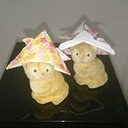Local levels of soluble tumor necrosis factor receptors in patients with allergic rhinitis are regulated by amount of antigen.
Keywords
Abstract
OBJECTIVE
To examine the possible correlation between the amount of antigen and the level of soluble tumor necrosis factor receptor (sTNFR), and to assess its biologic significance in allergic reactions.
METHODS
Randomized control trial.
METHODS
Twelve volunteers with Japanese cedar pollinosis and 10 healthy volunteers.
METHODS
The levels of p55 sTNFR (sTNFR1) and p75 sTNFR (sTNFR2) in samples of serum and nasal epithelial lining fluid (ELF) from 12 subjects with pollinosis and 10 healthy subjects were measured 4 times (preseason, early season, midseason, and postseason) in low (total, 415/cm( 2) per season) and high (total, 19,935/cm(2) per season) pollen-count periods, and the results were compared among the 4 groups.
RESULTS
In the low-pollen-count period, increased levels of sTNFR1 and sTNFR2 were observed in ELF samples from the allergic subjects during the midseason. In contrast, in the high-pollen-count period, those levels were already elevated during the preseason and reduced during the midseason. Especially, the levels of sTNFR2 in ELF samples from the allergic subjects during the midseason in the high-pollen-count period were significantly lower than those in the low-pollen-count period. Moreover, a significant negative correlation (sTNFR1, R = -0.82; sTNFR2, R = -0. 73) was found between the levels of sTNFR1 and sTNFR2 in ELF samples and the scores of symptoms in the allergic subjects in the high-pollen-count period, but not in the low-pollen-count period.
CONCLUSIONS
In patients with pollinosis, the amounts of antigen regulate the local levels of sTNFRs, possibly inhibiting nasal allergic inflammation.



